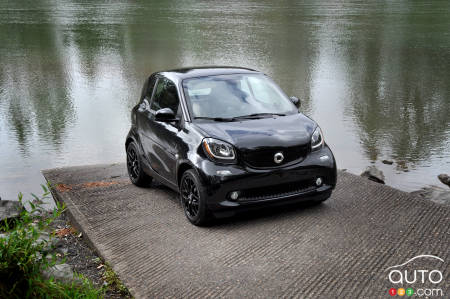The immanently looming million-dollar litre of fuel struck a chord with many an automaker. Mercedes took note in the mid-'90s and began work on what would soon become known as the smart car. Europe and other markets got theirs in the late '90s, but we Canadians got our first sampling in the mid-2000s.
I was lucky enough to drive a smart roadster, forfour and fortwo in 2002 and immediately fell in love with the easy-going yet feisty little cars. The forfour was not like the others and as such, was not my favourite. The fortwo really got my attention, and I quickly understood that the driver needed to conform to the car’s will and not the other way around.
What made a smart
As a quirky -- some would say, underpowered -- car equipped with a transmission that had a mind of its own, there was no way the fortwo was going to be anything but a city car. It was an excellent one at that, if you understood how you needed to act with the car. In other words: little or no passing, limited interior space and amenities, and that “special” automated manual transmission.
The latter item is what Mercedes and smart mainly addressed when they redesigned the car for this, its third generation. The main “issues” with the first two generations of the smart fortwo were its cutesy design and lack of power. The third generation W453 fortwo addresses all of this, and I can tell you that it’s the best smart that’s ever been built.
This makes me a little sad, as I was a huge fan of the minute oddball it once was -- but I’m an oddball myself. For the “normies,” smart now has the 3-door microcar you’ve always wanted and asked for.
New styling and tougher than ever
The highlights are numerous. The 2016 looks like Insectosaurus (fun movie, btw) thanks to its new larger headlights (and taillights) and newfound outer dimensions. I’m possibly exaggerating ever so slightly as the smart car remains 2.69 metres long; however, and most importantly, its width and track have gained 10 cm. I once spent 5 days in a W451 with a guy my old size (love you, Ben!) driving through the Arctic in our winter coats, and only elbowroom proved to be an issue. Well, that’s in the past now.
The fortwo’s redesign, now based on a Renault/smart platform includes more than just aesthetics such as a black front lower grille, body-colour bumpers, a new honeycomb rad grille, 15" and 16" wheels, 30 different colour combos, roof spoiler integrated with rear stop light, and more. What you see in the gallery is a new smart that’s built with materials that are conceived for safety, stiffness, and refinement.
The famous Tridion safety cell is the main element in the fortwo’s safety plan, but it’s not alone. Much of the car is now composed of ultra high-strength hot-formed steels and maximum-strength multiphase steel. In fact, 72% of the steel on the car is of the high-strength kind, far more than the previous car. Here’s a nice nugget of knowledge: the cell is made by Magna, near the Hambach, France plant where the fortwo is built.
Interior for adults
The outer shell is an evolution, however, the cabin is a revolution over the old smart. The dashboard’s layout is a departure in the right direction; think flying to Hawaii vs. Siberia. smart’s unique flavour still flows, but it’s far more sophisticated. The gauge cluster now holds a 3.5” screen and the tachometer is off to the left-hand of the cluster. The HVAC vents protrude out the top of the dash, and material covers most of what should be plastic. The climate controls include a cool magnified slider that looks as though it should be in a late ’50s Edsel and not a 2016 smart fortwo.
Getting aboard the smart car is very easy thanks to the large doors, and the seats are welcoming and comfortable. Elbowroom is improved, a direct result from the wider track. The steering wheel is not height adjustable or telescoping, but I managed a good driving position nevertheless. The trunk is still snug, but with the front passenger seat down, will accommodate up to 350 litres of stuff, 10 more than the old car.
The smart audio system has smartphone integration capability. Optionally, you can get a 7” touchscreen package that will satisfy all tablet users.
Turbo power!
The real story -- from a gear-head POV -- is the new engine and transmission choices. The turbocharged 900cc (0.9L) 3-cylinder engine is a little gem. Its 89 horsepower @ 5,500 rpm and 100 lb-ft of torque @ 2,500 rpm are tremendous fun. This kind of power in a roughly 900 kg car is enough to send the 5-speed manual version to 100 km/h in 10.7 seconds and the 6-speed DCT in 11.1 seconds. Top speed is now 155 km/h.
Manual?
You betcha! And it’s a sweet ‘box too! Clutch action is easy, the friction point is evident and the shifter rows merrily. The throws are a bit long, but it more than gets the job done. As an option, you can mate the mill with a new 6-speed dual-clutch twinamic transmission. This one’s a revolution, too. The old tranny was the most complained about aspect of the previous car, and Mercedes/smart listened to its customers.
The twinamic is the logical choice for the smart fortwo as, you might have guessed, this is the urban smart car par excellence. Gone is shift-mongering, severe delays, slop, and general unpleasantness from the old single-clutch 5-speed. On top of that, depending on trim and options, you get a sport mode and paddle shifters!
The 2016 fortwo feels faster than its number suggest. The low-end torque makes all the difference in the world, mostly in the city. It reminds me of the 1st generation CDI diesel. On the highway, passing is possible and going quickly does happen. You’ll still get no respect from most others on the road, but this time around it is possible to accelerate away. And even if you push it hard, you’ll never consume much more than 6L/100km.
Rollin’ rollin’ rollin’
The combination of the new chassis, revised suspension and wider track are immediately evident in the drive. The new smart car is quieter, sure, but feels far more stable and planted. The suspension’s tuning is a wise mix between comfort and handling. Of the many standard safety features, crosswind assist is a nice touch, however, I can’t tell if I experienced it or not. I passed a number of semis on the road, crossed a bunch of bridges, and on day two we got lots of rain and some wind. Perhaps it’s that good…
Of the many fun driving aspects of the car, we have the responsive variable ratio power steering that allows for a very short 6.95 metre turning radius. On the topic of turning, the fortwo tends to understeer a fair amount especially if you accelerate when the wheels are not straight. The weight transfer to the rear is noticeable, thus unloading the front wheels, hampering steering. The smart’s smart yet non-deactivatable ESP system keeps everyone in check though. And lastly, the brakes are quite nice; pedal feel is good, a leap from the smart cars of yore.
Big fan here!
I truly enjoyed the new 2016 smart fortwo. Many efforts were made towards design, both inside and outside and to make it more appealing as a product and not a lesser (cheaper) car. Mercedes have done a great job, but there is a cost.
Base pricing has climbed to $17,300 (about $2,500 more expensive than the W451). The new smart car is loaded with new technology, amenities (cruise control, for example) and a more powerful engine. The true comparison would be with the $1,400 twinamic thrown in for a total of $18,700. The price jump may scare off some buyers but most fortwos sold were midrange versions so it shouldn’t be much of an issue. One thing is certain: This is a better car than the outgoing one.
The price of gas has yet to reach catastrophic levels and because of this, cars like the smart fortwo have suffered from a lack of “want.” Mercedes continues to push the little car and this latest iteration is the best, by far. Will it turn the tides for the 2-seater? Sadly, I think only the price of energy will have a true influence.
A few final points: There are three trims; Pure/Passion/Prime. Passion will account for 50%-75% of all sales. The gender split is 50/50. We know a convertible is coming and Mercedes people have confirmed that an EV is also on the way.
The new smart car will be on sale as of September 18th in Canada.



